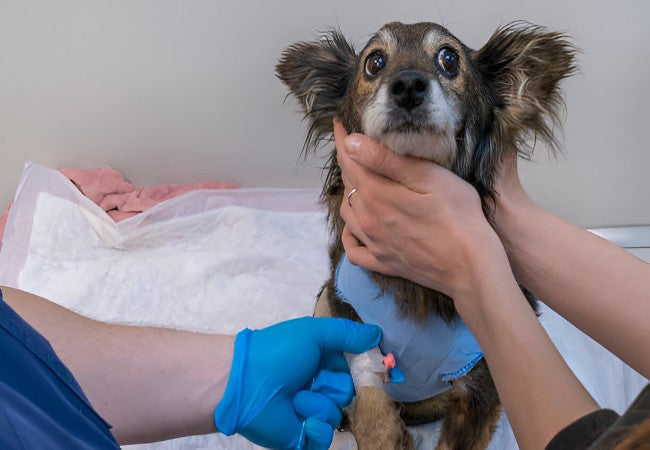Veterinary Guide to Canine Hypoparathyroidism 2025 🐶⚖️

In this article
Veterinary Guide to Canine Hypoparathyroidism 2025 🐶⚖️
By Dr. Duncan Houston BVSc
🧬 What Is Hypoparathyroidism?
Hypoparathyroidism is a disorder where the parathyroid glands fail to produce adequate parathyroid hormone (PTH), leading to low blood calcium (hypocalcemia) and often high phosphorus levels.
👥 Who’s Affected & Causes
- Idiopathic/immune-mediated parathyroid destruction—common cause in dogs.
- Iatrogenic: accidental removal/injury during thyroidectomy or neck surgery.
- Secondary hypoparathyroidism: due to low magnesium or chronic illness—magnesium must be checked.
- Rare causes: congenital absence, neck trauma, infiltration by disease.
⚠️ Clinical Signs
- Neuromuscular excitability: facial twitching, muscle tremors, stiffness, tetany, seizures.
- Behavior: anxiety, restlessness.
- Cardiac effects: arrhythmias, hypotension noted during IV calcium monitoring.
- Chronic signs: stiffness, muscle weakness; hyperphosphatemia from low PTH.
🔍 Diagnostic Approach
- History & exam: recent neck surgery, tremors, convulsions, stiffness.
- Blood tests: low total & ionized calcium, elevated phosphorus, and low PTH confirm diagnosis.
- Magnesium measurement: essential—magnesium deficiency can mimic hypoparathyroidism.
- Baseline work-up: CBC, chemistry, urinalysis to rule out other diseases.
🛠️ Treatment Overview
🆘 Emergency (Acute Crisis)
- Hospitalize—IV 10% calcium gluconate at 0.5–1.5 ml/kg slowly over 10–30 min under ECG monitoring.
- Monitor heart rhythm; pause infusion immediately if arrhythmias appear.
- For sustained supplementation, use CRI of calcium gluconate (2.5–10 mg/kg/h) or diluted subcutaneous injections.
🕒 Transition Phase
- Once stable, start oral calcium and vitamin D analog (calcitriol) while tapering IV therapy.
- Monitor serum calcium daily; aim for low-normal to prevent overshoot complications.
📌 Long‑Term Management
- Calcitriol (1,25‑dihydroxycholecalciferol): daily dosing orally to maintain calcium absorption; adjust every few days based on blood levels.
- Oral calcium supplements: calcium carbonate or gluconate with meals—dose tailored to lab results.
- Dietary adjustment: low phosphorus, moderate calcium diet; phosphate binders may be needed.
- Monitor: serum calcium, phosphorus, magnesium—initially weekly, then gradually every 4–12 weeks once stable.
- Be vigilant for hypercalcemia: adjust dosage accordingly to prevent nephrocalcinosis or soft tissue mineralization.
📈 Prognosis
- Excellent with consistent therapy and monitoring—dogs live long, quality lives.
- Idiopathic cases require lifelong supplementation; iatrogenic cases may remain lifelong.
- The risk of complications (e.g., kidney damage) is minimized with proper dosages and lab follow-up.
📱 Ask A Vet Telehealth Integration
- 📸 Upload lab results, ECG snapshots, and clinical videos for veterinary review.
- 🔔 Get customized dosing reminders for calcium, calcitriol, and lab rechecks.
- 🩺 Remote check-ins to assess tetany, appetite, energy, and hydration.
🎓 Case Spotlight: “Rusty” the Spaniel
Rusty, a 5‑year‑old Cocker Spaniel, had neck surgery to remove a thyroid mass. Two days post-op, he developed facial twitching and tremors; labs showed ionized Ca 0.7 mmol/L, phosphorus 7.2 mg/dL, and PTH was low. He received IV calcium gluconate in the hospital, then transitioned to oral calcitriol and calcium carbonate. Ask A Vet supports with dosage reminders, lab uploads, and supplement delivery. Within two weeks, Rusty’s calcium stabilized and symptoms ceased; over months, his dosing tapered, and he returned to normal life 🐾.
🔚 Key Takeaways
- Hypoparathyroidism is a PTH deficiency causing hypocalcemia, often post-surgical or idiopathic.
- Watch for tetany, tremors, seizures, and cardiac signs in at-risk dogs.
- Confirm with ionized Ca, phosphorus, and PTH levels; rule out magnesium deficiency.
- Treat acute cases with IV calcium, then shift to oral calcium + calcitriol for maintenance.
- Frequent monitoring is vital to balance efficacy and avoid complications.
- Ask A Vet telehealth improves outcomes with guided dosing, lab reviews, remote check-ins, and home delivery support 📲🐕
Dr Duncan Houston BVSc, founder of Ask A Vet. Download the Ask A Vet app to manage or prevent hypoparathyroidism—Get expert telehealth support, supplement coordination, dosage coaching & continuous monitoring for your dog’s well‑being 🐶📲






